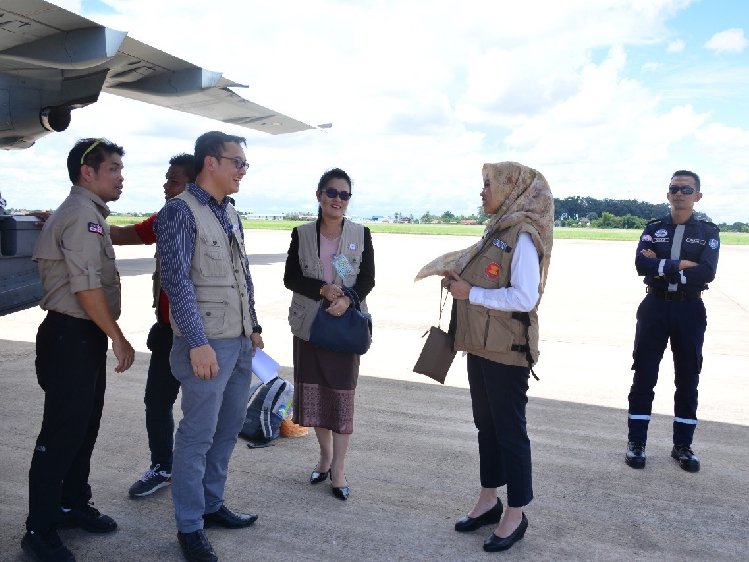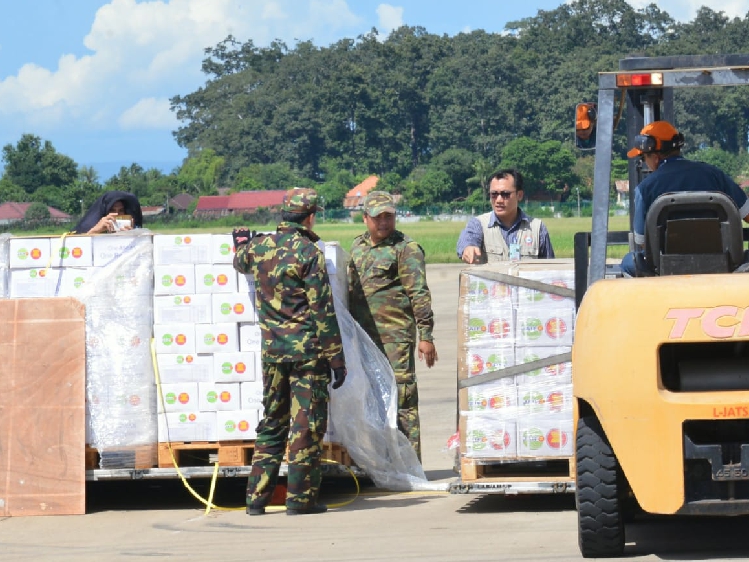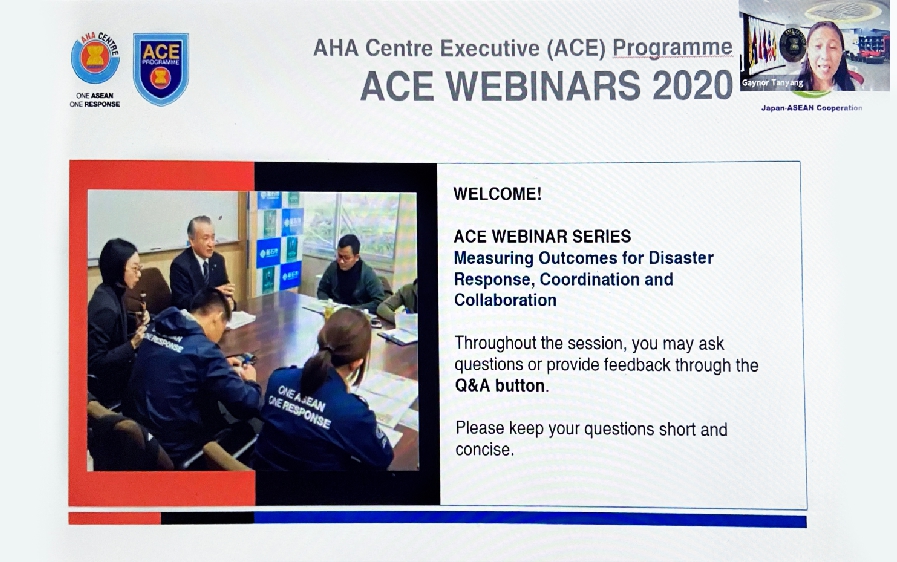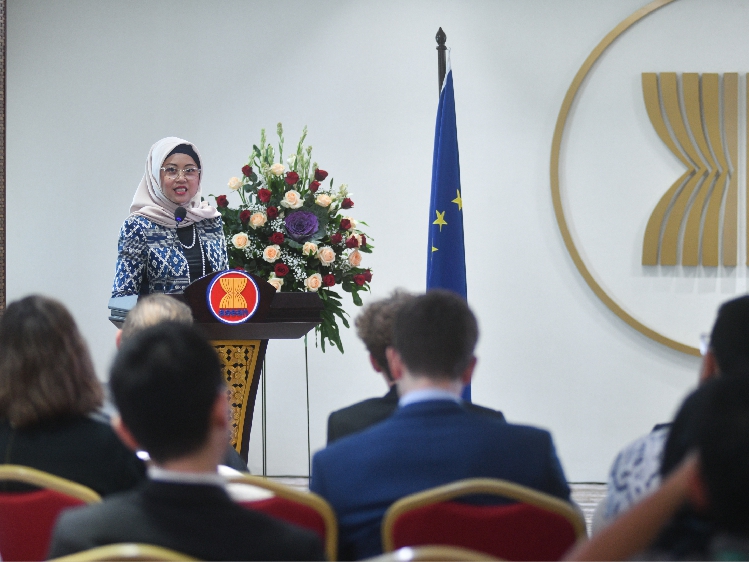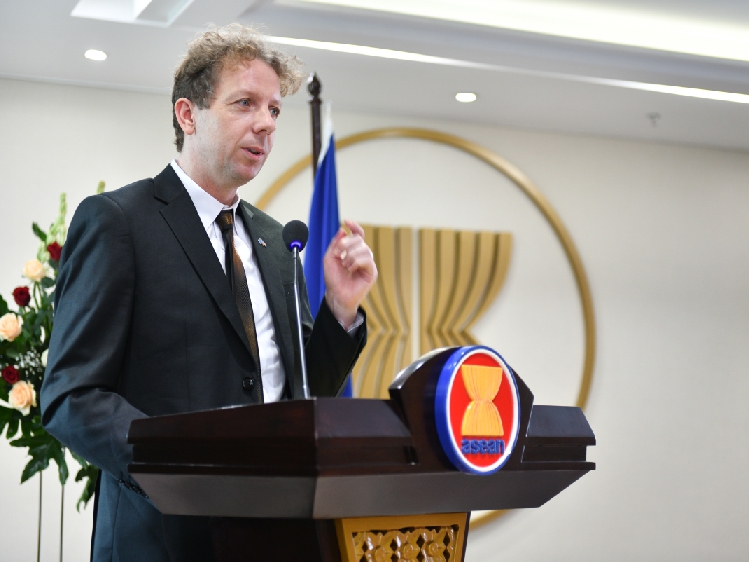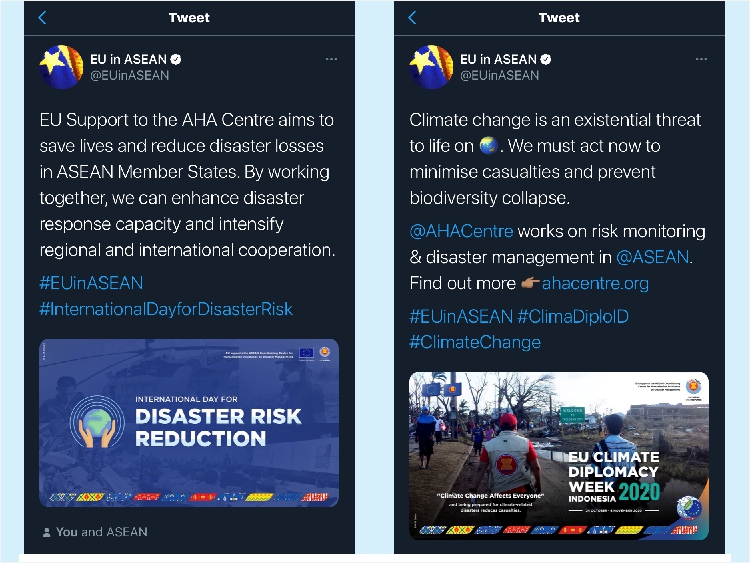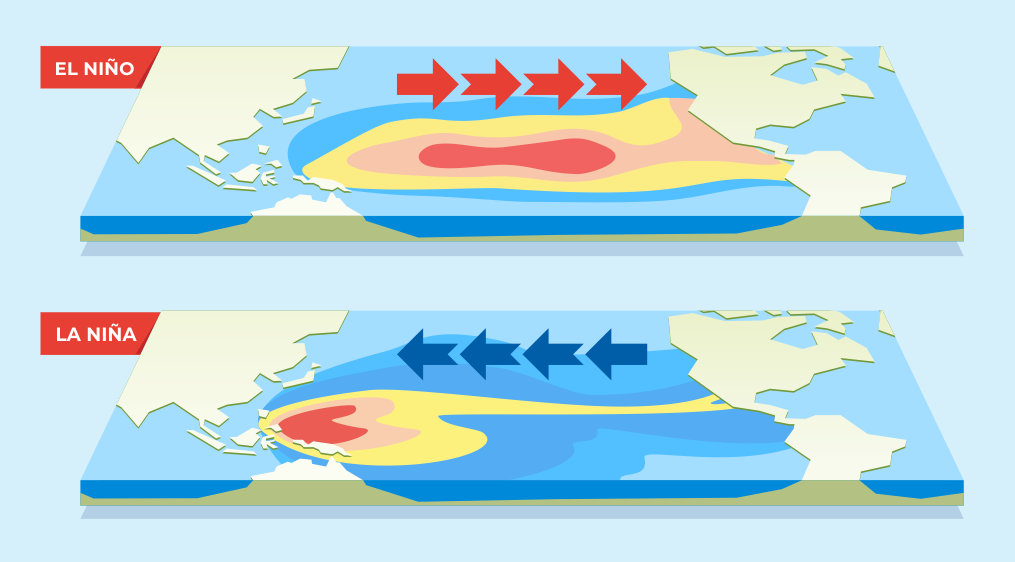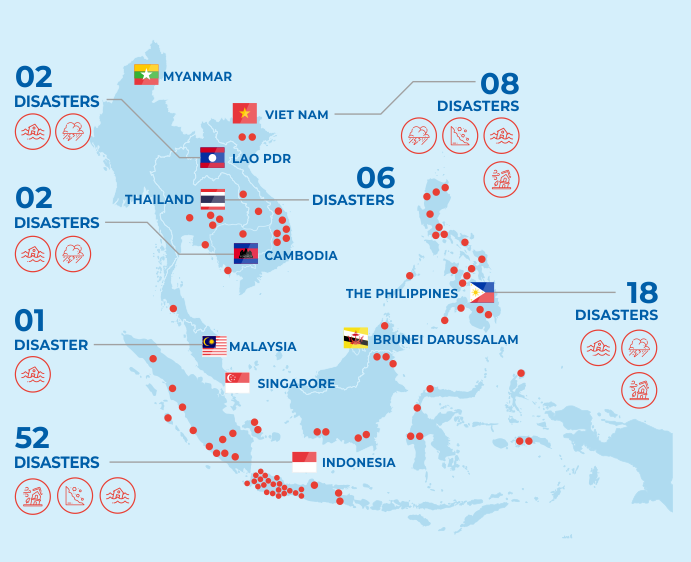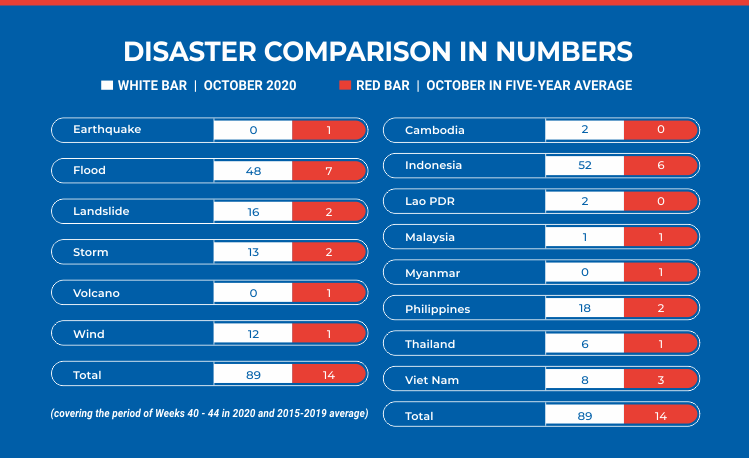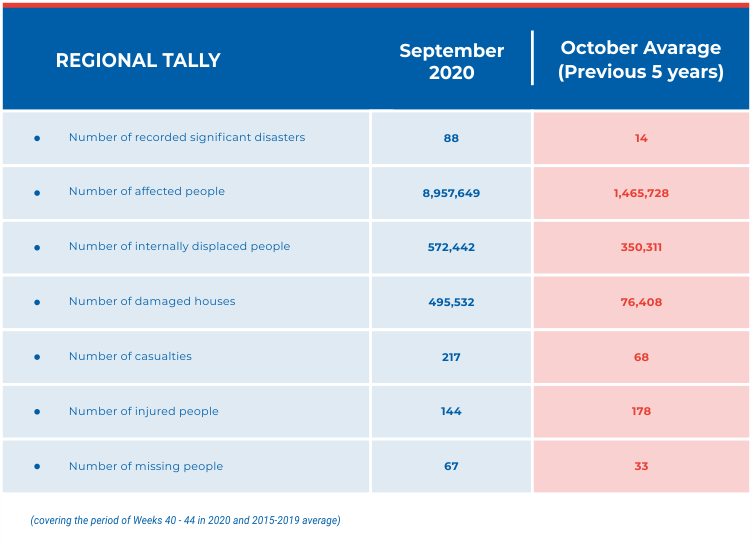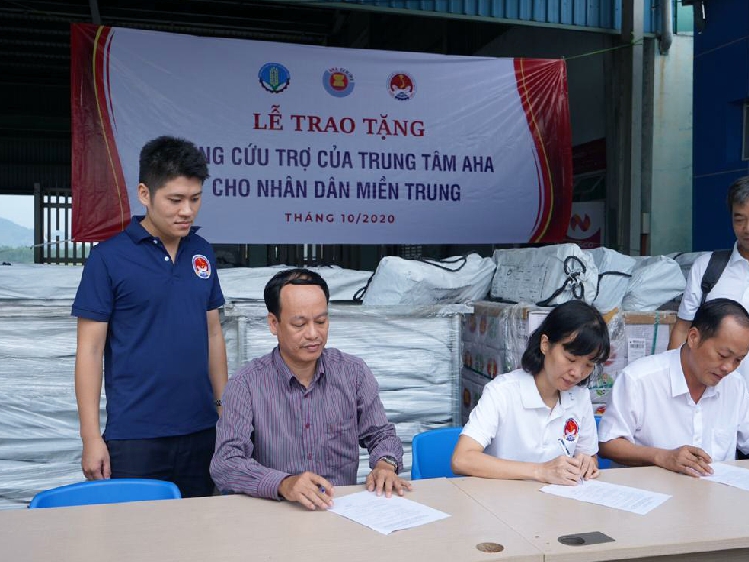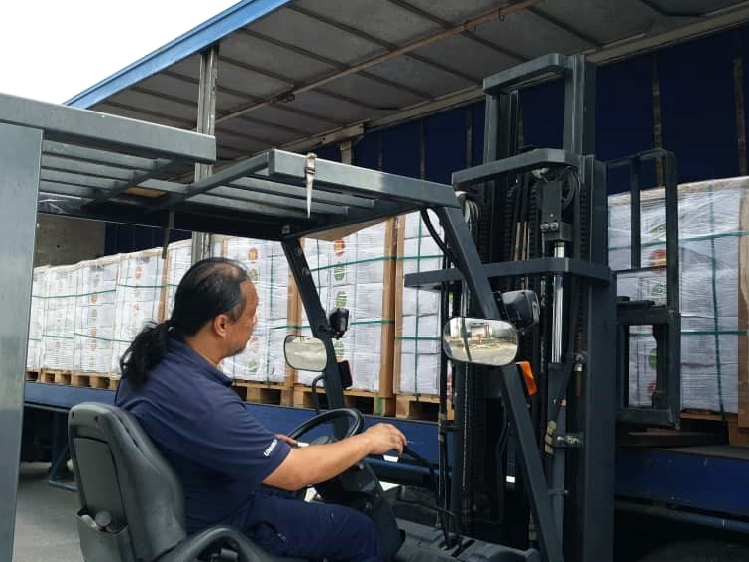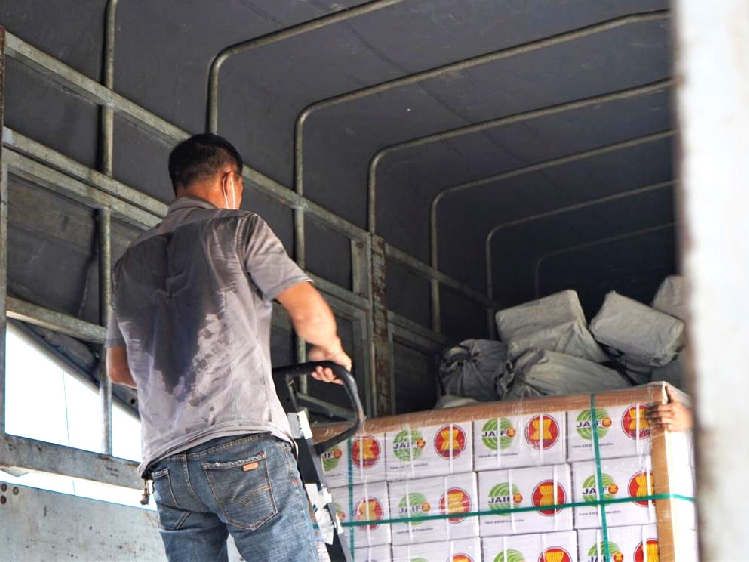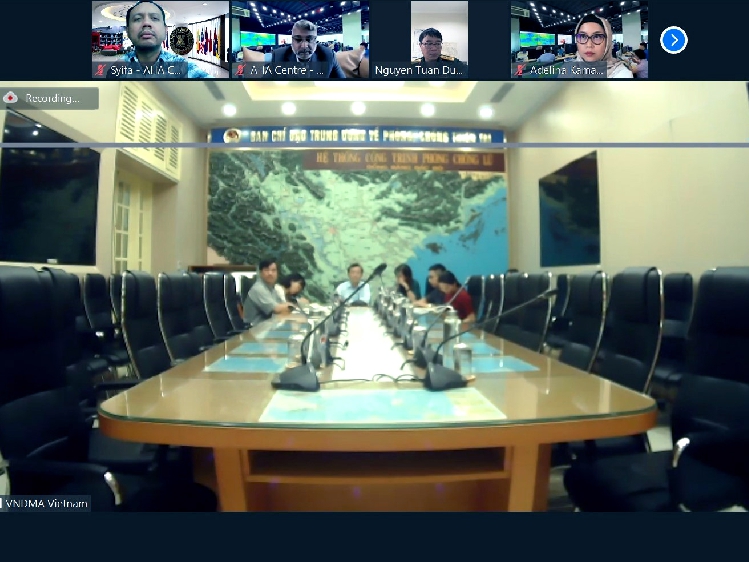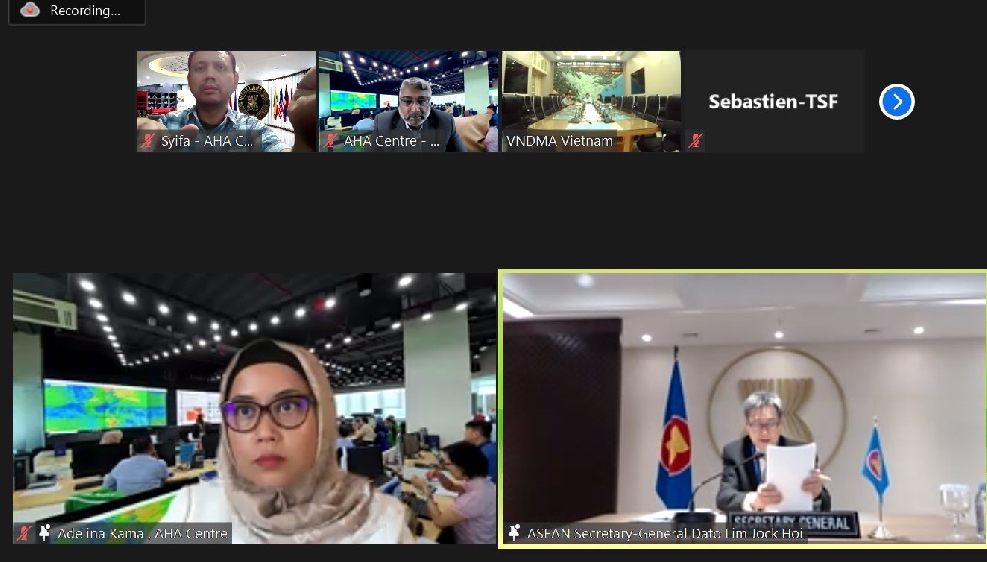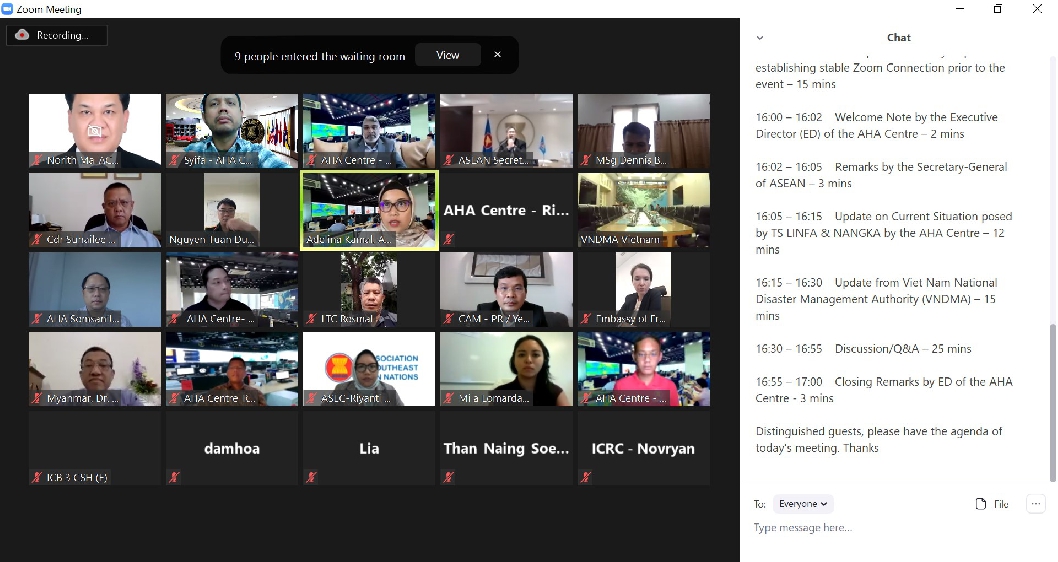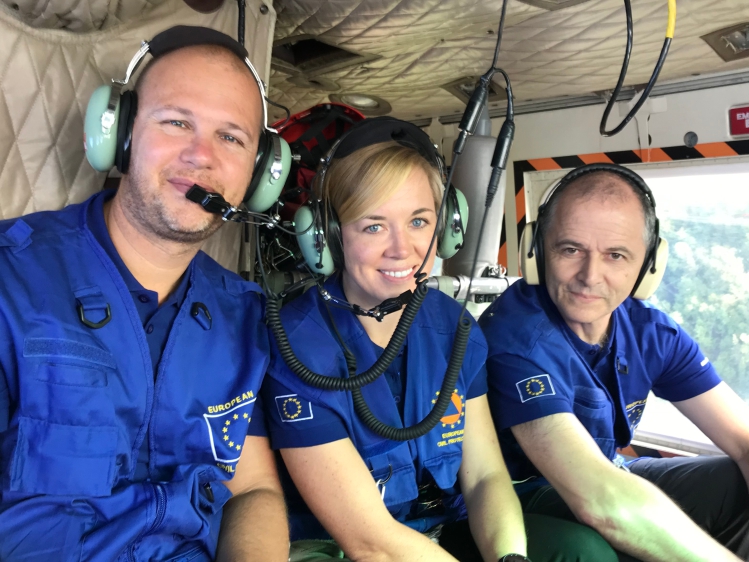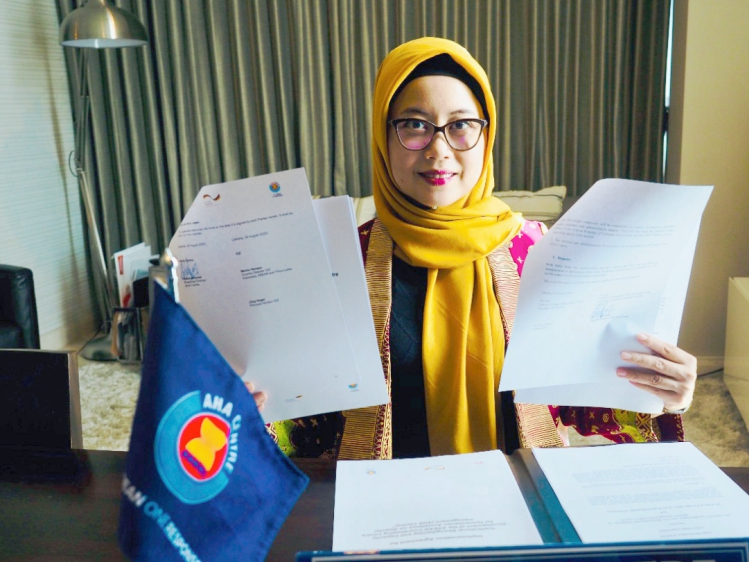Vol 66 – SOMBATH DOUANGSAVANH

SOMBATH DOUANGSAVANH
Mr. Sombath Douangsavanh is the Deputy Director of the Disaster Preparedness and Response Division, Social Welfare Department, of the Lao PDR Ministry of Labour and Social Welfare (Lao PDR’s National Disaster Management Organisation – NDMO). He works primarily as the ASEAN and International Cooperation National Programme Coordinator in the Integrated Programme for Climate Resilience and Empowerment, based in Attapeu province, Lao PDR.
Mr. Sombath took some time out this month to answer questions from the AHA Centre relating to his work, his experience with the AHA Centre programmes, and the overall disaster management context for Lao PDR.
When asked about the challenges he faces in his current position, Mr. Sombath identified the uniqueness of working in the middle-level management. “On the middle management level, most of our work is more on technical-focused, however as the Social Welfare Department acts as the Secretariat of Central Disaster Management Committee, that work is more focused on monitoring disaster management implementation, meaning we have a broad area of skills to encompass” he explained. “Additionally, leading the ASEAN and International Cooperation Emergency Operation Centre, I also have had to increase my knowledge and skills related to such things as situation analysis’, GIS remote sensing, and data management.”
Mr. Sombath also highlighted that he has strengthened many of his skills and experiences through engagement with the AHA Centre over the years. He identifies his participation in the AHA Centre Executive (ACE) Programme as a key moment in his career. “The ACE Programme provided very comprehensive knowledge and skills from basics of disaster management, understanding the ASEAN context, UN and Red Cross mechanisms and specific skills, and also engaged us in the ASEAN-ERAT and other leadership efforts” he recalled. Mr. Sombath also believes it was these such engagements that have supported his career progression to this point, stating that “by having this kind of support and engagement, I have been promoted to a higher position, and utilise the knowledge gathered from ACE to manage my tasks and my team”. “Also, when a disaster situation arises, my skills can be used to support the emergency response effort”, Mr. Sombath said.
Mr. Sombath values learning and reflection both individually and with his wider team, and believes that networking and partnerships are the most important part of strong disaster management. He also has great hopes for the ASEAN region to continue its progression in all aspects of disaster management, and that the ASEAN mechanisms continue to strengthen and are effectively applied in disaster management across the region and also outside. Mr. Sombath finishes with a reminder to all disaster managers about the importance of complete and all-encompassing disaster management activities, and the importance that such activities are fully supported.
“We never hope disaster happens, however, to be better prepared, ASEAN Member State governments must continue to invest more on all disaster risk reduction efforts – not only response, but preparedness and recovery as well.”
Written by : Moch Syifa | Photo : Mr. Sombath Douangsavanh
- Published in The Other Side
Vol 66 – ACDR2020 (ASIAN CONFERENCE ON DISASTER REDUCTION 2020)

ACDR2020
(ASIAN CONFERENCE ON DISASTER REDUCTION 2020)
The Asian Disaster Reduction Centre (ADRC), since its establishment in 1998, has capitalised on the development of human and information resource management in order to enhance the disaster risk reduction capabilities of member countries. Through one of its activities—the Asian Conference on Disaster Reduction (ACDR) – this resource development is carried out, while also serving as a venue for annual conferences to be hosted by one of the member countries. For the first time in 19 years, the ACDR 2020 was organised virtually due to the COVID-19 pandemic.
According to the ADRC, hazards that have resulted in disasters have resulted in increasing impacts throughout recent years. This comes despite the continued efforts by member countries to implement the Sendai Framework for Disaster Risk Reduction (SFDRR). These facts have shed light on the urgency of implementing and adapting Disaster Mitigation and DRR Strategies that take climate change into “greater consideration, especially in the context of the coronavirus pandemic”.
The 2020 conference focused on how national disaster management organisations, civil society organisations, and other relevant authorities and agencies deal with the dual risks of climate change and COVID-19. In the ACDR 2020, member countries shared their situations and discussed future actions that focused on two themes, namely:
1. DRR Measures and Challenges to the Intensifying Disaster Risks, and;
2. Disaster Preparedness and Response Amidst COVID-19.
During the ACDR 2020, the AHA Centre had the privilege to present on how it undertakes disaster information management. The presentation highlighted the resilience and adaptability of the AHA Centre’s processes and mechanisms during the pandemic—including even being able to conduct operations and responses through virtual means. Bangladesh presented an interesting insight into addressing issues and challenges for disaster risk reduction under changing disaster conditions and climate change, while Singapore presented on addressing issues and challenges for disaster risk management in the “New Normal” resulting from the pandemic.
Overall, the conference provided a platform for organisations in member countries to share to and learn from one another, engaging on best practices in adapting to changing landscapes battered by climate change, and even further by COVID-19.
Written by : Keith Paolo Landicho | Photo : AHA Centre
- Published in AHA Centre Diary 2
Vol 66 – ACE WEBINAR: MEASURING OUTCOMES FOR DISASTER RESPONSE, COORDINATION AND MANAGEMENT

ACE WEBINAR:
MEASURING OUTCOMES FOR DISASTER RESPONSE,
COORDINATION AND MANAGEMENT
While the global pandemic has interrupted capacity building efforts such as the AHA Centre Executive (ACE) Programme, the Centre continues to provide education for ACE Programme graduates. The AHA Centre recently implemented a webinar series to support its objectives of capacity-building, networking, and utilising leadership competencies to improve national and regional coordination response mechanisms and disaster management more broadly. The webinars run from September to November 2020, and are primarily intended to expose the ACE Programme graduates to the latest trends and challenges in disaster management.
Following the success of the first ACE Webinar during September, the AHA Centre conducted the second ACE Webinar – namely Measuring Outcomes for Disaster Response, Coordination and Management – on 21 October, 2020. The webinar engaged more than 142 humanitarian practitioners from the ACE Programme graduate pool, NDMO officers, partners, and academics, in particular those working in monitoring and evaluation. Experts from UNOCHA, IFRC, Save the Children (member of the AADMER Partnership Group), and the Lien Centre for Social Innovation from Singapore Management University (SMU), shared their experiences in measuring the effectiveness of disaster response.
The session began with an interactive session on how often participants assess certain aspects during disaster operations – including measurement of coordination, response team effectiveness, accountability to affected population, leadership, and adherence to the programme cycle. Participants highlighted that coordination was the most frequent aspect that they measure in disaster response. This was highlighted further by the UNOCHA’s presentation, which focused on the importance of coordination to evaluate disaster responses, to ensure that assistance reaches the affected population, and to avoid gaps and duplication of assistance. This notion was also echoed by the speaker from the Lien Centre for Social Innovation, who also stated that cross-sectoral collaboration should create strong results for all stakeholders. ACE Programme Graduate Ms. Sarah Ulat of the Philippines Office of Civil Defense – National Disaster Risk Reduction and Management Council of the Philippines moderated the webinar, and also highlighted the importance of partnerships as a force multiplier and as a mode to a highly enabling environment for all agencies.
The speaker from IFRC shared experiences in measuring the effectiveness of surge teams undertaking internal reviews and utilising performance management and appraisals. The speaker from Save the Children covered the importance of assistance reaching vulnerable groups – including children – as they often make-up large percentages of an affected population.
Failure to listen to or consult with children in response evaluations not only neglects important information, but also ignores children’s agency and ability to participate in decision-making processes that affect their lives.
The webinar concluded with some key takeaways provided by ACE Programme Graduate Mr Muhammad Azhar bin Said of the Singapore Civil Defence Force.
“Monitoring, evaluation and coordination is a continuous process to ensure the effectiveness of the humanitarian response. These days, with the advance of technology, we should be able to transform the way we undertake responses. After all, leadership is extremely important to be able to deliver productive and successful operations”.
-Mr Muhammad Azhar bin Said
Written by : Ferosa Arsadita | Photo : AHA Centre
- Published in AHA Centre Diary 1
Vol 66 – EU-SAHA THROUGH THE EUROPEAN UNION

EU-SAHA THROUGH THE EUROPEAN UNION
The Integrated Programme in Enhancing the Capacity of AHA Centre and ASEAN Emergency Response Mechanisms, known as the EU-SAHA programme, is an initiative aimed to strengthen the capacity and sustainability of the AHA Centre in order to achieve operational excellence in disaster monitoring and emergency response, as well as enhance mechanisms for ASEAN leadership to ‘respond as one’ through excellence and innovation in disaster management.
Funded through a partnership with the European Union, the programme is being implemented across four years from December 2019 to December 2023, utilising a total fund amount of EUR 7.2 million. The EU has also awarded funding to the Swedish Civil Contingency Agency and the Estonian Rescue Board to complement activities directly implemented by the AHA Centre through this programme, in the form of the Leveraging ASEAN Capacities for Emergency Response (LACER) project. LACER will be implemented with an overall focus on institutional capacity development to augment sustainability and utilisation of AHA Centre’s operational capacity. The project is also aligned with the ASEAN-EU Plan of Action (2018-2022), more specifically within the “Enhance cooperation on Crisis and Disaster Management” objective found within the plan.
The AHA Centre also forms the operational counterpart of the EU Emergency Response Coordination Centre (ERCC) under the Directorate-General for European Civil Protection and Humanitarian Aid Operations (DG-ECHO). These above initiatives and more will enable ASEAN and the European Union to further strengthen their partnership in disaster management and disaster risk reduction across their respective regions, through a sustained longer-term institutional collaborative effort that is in line with their commitments and obligations at the global level. The launching ceremony for the EU-SAHA programme was held at the ASEAN Secretariat in Jakarta on 27 January 2020. The Secretary-General of ASEAN H.E. Dato Lim Jock Hoi, the Ambassador of European Mission to ASEAN H.E. Igor Driesmans, and the Executive Director of the AHA Centre Ms Adelina Kamal were all in attendance at the opening ceremony.
The AHA Centre is utilising a multi-level approach to implement the programme, which is undertaken by engaging at national, regional, and inter-regional levels within ASEAN and the EU. At the regional level, the AHA Centre focuses on the implementation of regional activities that involve all ASEAN Member States, which is also in line with the AADMER Work Programme and the AHA Centre Work Plan, alongside other key documents on disaster management that have been adopted by ASEAN Leaders. At national level, it focuses on facilitation of required training and activities aimed to increase the capacity and capabilities of Member States on disaster management, with the National Disaster Management Organisations forming the main national focal points. On the inter-regional level, the key focus is the exchange of knowledge and training between the AHA Centre and the ASEAN Member States with relevant EU and UN institutions, and other international organisations. The primary aim at this level is to enhance skills and capacity to prepare for responding both inside and outside the regions.
Written by : Moch Syifa | Photo : AHA Centre
- Published in Partnership
Vol 66 – GETTING TO KNOW EL NIÑO & LA NIÑA

GETTING TO KNOW
EL NIÑO & LA NIÑA
El Niño and La Niña are complex weather patterns resulting from variations in ocean temperatures in the Equatorial Pacific. As we begin the latest La Niña phase, we can take a little time to learn about their history and what they really mean for our current weather and climate.
EL NIÑO
El Niño means the Little Boy – or Christ’s Child – in the Spanish language. It was originally recognised by fishermen off the coast of South America in the 1600s, and was formed by the appearance of unusually warm water in the Pacific Ocean for a certain time of the year. The name was chosen based on this time of year (which was around December), during which these warm water events tended to occur more often.
In modern times, the term El Niño refers to the large-scale ocean-atmosphere climate interaction that is linked to a periodic warming in sea surface temperatures across the central and east-central Equatorial Pacific region. Typical El Niño effects usually develop over the Northern America continent during the winter season, and is signified by warmer-than-average temperatures over western and central Canada, as well as over the western and northern United States. Wetter-than-average conditions are likely over portions of the U.S. Gulf Coast and Florida, while drier-than-average conditions are found in the Ohio Valley and the Pacific Northwest. The presence of El Niño can significantly influence weather patterns, ocean conditions, and marine fisheries across large portions of the earth for an extended period of time, and have significant causal effects on other weather-related events.
LA NIÑA
La Niña, on the other hand, is Spanish for the Little Girl. La Niña is also sometimes known locally as El Viejo, anti-El Niño, or ‘a cold event’. Simply put, it forms the opposite conditions to the El Niño event.
La Niña episodes represent periods of below-average sea surface temperatures across the east-central Equatorial Pacific. La Niña impacts on the global climate tend to be opposite those caused by El Niño, and in the tropics, ocean temperature variations in La Niña also tend to be on the opposite end to the weather patterns attributed to El Niño. In general, during a La Niña year, winter temperatures are warmer than usual in the southeast of the Northern American continent, and cooler than normal in the northwest.
Source: https://oceanservice.noaa.gov/facts/ninonina.html
- Published in Insight
Vol 66 – MONTHLY DISASTER REVIEW AND OUTLOOK

MONTHLY DISASTER REVIEW AND OUTLOOK
OCTOBER 2020 | DISASTER MONITORING & ANALYSIS
(DMA) UNIT, AHA CENTRE
GENERAL REVIEW OF OCTOBER 2020
A total of 89 disaster events were recorded for the month of October 2020, which is almost twice the amount recorded in September 2020 (45), and is eight times the amount recorded in October 2019. The number of recorded disasters for the month is also six times that of October’s previous five-year average. Along the same lines, the figures show significantly higher occurrences of affected people, internally displaced people, damaged houses, casualties and missing persons when compared to the previous 5-year averages, however, there was a decrease in the number of disaster-related injuries recorded. Such high figures can be attributed to the impact of tropical cyclones that affected the Philippines and Viet Nam (namely Tropical Depression OFEL and Typhoon MOLAVE). A combination of weather systems has also been reported as affecting both Cambodia and Lao PDR according to the National Disaster Management Office of Lao PDR and the National Committee on Disaster Management of Cambodia. Additionally, with the onset of La Niña conditions, torrential rains became more likely across the ASEAN region, and with this, the potential for hydro-meteorological and climatological disasters is significantly higher than previous five-year averages – according to the ASEAN Specialised Meteorological Centre and the Bureau of Meteorology Australia.
On the geophysical front, a total of 33 significant earthquakes (M≥5.0) were reported in the region during October 2020. Ongoing volcanic activity was reported for the Indonesian mountains of Ibu, Semeru, Dukono, and Kerinci, as well as Bulusan, Kanlaon and Taal mountains in the Philippines. No significant damage occurred as a result of volcanic activity during October 2020, which in some cases can be attributed to improved preparedness and response mechanisms around the active volcanic areas.
SEASONAL OUTLOOK
The Southwest Monsoon gradually made way for inter-monsoon conditions during early November 2020, as the prevailing winds over the ASEAN region became generally weak and variable. Inter-monsoon conditions are characterised by increased shower activities over most parts of southern ASEAN, as the monsoon rain band lies close to the equatorial region. The inter-monsoon conditions are expected to last for around one month, before transitioning to the Northeast Monsoon. During the Northeast Monsoon, the northern ASEAN region enters its traditional dry season, while the southern ASEAN region can expect more rainy weather.
For the November 2020 to January 2021 period, above-average rainfall is predicted for the ASEAN region south of the equator, as well as the Philippines and parts of Viet Nam, Lao PDR, and Cambodia. La Niña conditions are present over the tropical Pacific Ocean, with most climate models predicting La Niña conditions to persist for this period, of which will typically result in wetter-than-average conditions over the Southeast Asia region. In turn, the region should expect a potential increase in hydro-meteo-climatological hazards (floods, flash-floods, rain-induced landslides).
While warmer-than-average temperatures are expected to continue over much of the Maritime Continent for the next three months, parts of Cambodia, Lao PDR, Thailand and Viet Nam may experience below to near-normal temperatures.
With wetter conditions expected in November, the hotspot activities in the southern ASEAN region are forecast to remain subdued, although isolated hotpots and localised smoke plumes may still be detected during brief periods of drier weather. A gradual increase in hotspot activities may be expected over the northern ASEAN region from December 2020, as this is the period when the region enters its traditional dry season with the onset of Northeast Monsoon.
Data Sources: ASEAN Disaster Information Network, ASEAN Specialised Meteorological Centre
Written by : Keith Paolo Landicho, Lawrence Anthony Dimailig
DISCLAIMER
Disclaimer: AHA Centre’s estimation is based on data and information shared by National Disaster Management Organisations (NDMOs) and other relevant agencies from ASEAN Member States, international organisations and news agencies. Further information on each recorded-significant disaster, description and detail of data and information are available at: http://adinet.ahacentre.org/reports.
- Published in Monthly Disaster Outlook
Vol 66 – TROPICAL STORMS LINFA AND NANGKA: THE AHA CENTRE’S FIRST DISASTER RESPONSE AMIDST THE PANDEMIC

TROPICAL STORMS LINFA AND NANGKA:
THE AHA CENTRE’S FIRST DISASTER RESPONSE AMIDST THE PANDEMIC
Significant weather activity during the middle of October, 2020, saw the AHA Centre mobilised ASEAN relief items in response to Tropical Storms LINFA and NANGKA that struck Viet Nam. Supported through the Japan-ASEAN Integration Fund (JAIF), the relief items were airlifted from the Disaster Emergency Logistics System for ASEAN (DELSA) regional stockpile in Subang, Malaysia, with the assistance of the United Nations Humanitarian Response Depot (UNHRD). The items included 1,300 kitchen sets and 1,000 shelter repair kits, and reached Da Nang International Airport, Viet Nam in the evening of the 20th of October.
Ms Adelina Kamal, the Executive Director of the AHA Centre, stated that the AHA Centre worked closely with the Viet Nam Disaster Management Authority of the Ministry of Agriculture and Rural Development – Viet Nam Central Steering Committee for Natural Disaster Prevention and Control, to monitor the impact of Tropical Storms LINFA and NANGKA. “We also intensified our disaster monitoring efforts from early October, after identifying the formation of the tropical storms,” Ms Kamal explained.
According to Ms Kamal, the relief items represent the tangible assistance and solidarity of the ASEAN nations, under the spirit of ‘One ASEAN, One Response’. This was also the AHA Centre’s first natural disaster response amidst the COVID-19 pandemic context, which meant that most preparations, including at the Emergency Operations Centre (EOC), were conducted remotely.
The disaster response effort within the pandemic context created a range of other new challenges for the AHA Centre team. Engaging partners and all other response stakeholders within a remote environment was a primary focus of the AHA Centre, as it worked out new and innovative ways to ensure its primary role was fulfilled regardless of the limitations caused by the situation. On 15 October, the AHA Centre organised an online Executive Briefing for all ASEAN Member States, diplomatic missions and humanitarian partners, together with the Secretary-General of ASEAN and the Viet Nam Disaster Management Authority. This gathering worked to provide situational awareness and a common operating overview of the impacts resulting from Tropical Storms LINFA and NANGKA in the ASEAN region. The briefing was attended by over 40 invitees, including the Secretary-General of ASEAN H.E. Dato Lim Jock Hoi and the Deputy Director-General of the Viet Nam Disaster Management Authority (VNDMA) Mr. Nguyen Van Tien. Both these key stakeholders also provided strong and clear input during the Executive Briefing.
The widespread floods caused by Tropical Storms LINFA and NANGKA not only affected multiple provinces through central Viet Nam, but also impacted other areas in Cambodia and Lao PDR. More than 800,000 people in Viet Nam were affected by the storms, with more than 66,500 people evacuated. The AHA Centre remained on stand-by to support and coordinate with the Viet Nam Disaster Management Authority, as well as continue to monitor the situation in Viet Nam and other ASEAN countries. “We do hope that the relief items will lighten up the spirit of the communities affected by the storms in central Viet Nam,” Ms Kamal added.
Written by : Moch Syifa | Photo Credit : VNDMA for AHA Centre
- Published in Highlight
Vol 65 – KAJSA SJÖSVÄRD

KAJSA SJÖSVÄRD
This month the AHA Centre invited Kajsa Sjösvärd – an international roster member from the Swedish Civil Contingencies Agency (MSB) and disaster management professional – to provide an insight into her work in disaster management both internationally and within Sweden. Topics ranged from the current pandemic response through to leadership and the sector in general, and we bring to you some of Kajsa’s key experiences and recommendations from the wide-ranging interview.
“My focus is on how to set up a well-functioning staff function, how to optimize it and how to maintain the personnel on a good energy level, despite the stressful environment”
Kajsa has recently been appointed team leader of the MSB’s LACER project being implemented with the AHA Centre, which provides her a new experience of working in the ASEAN region, to go alongside over a decade of experience with MSB and also locally in Sweden. “I am the Director of Crisis Management and Societal Safety at the County Board of Dalarna, in Sweden, and within that capacity I often take on the role of Chief of Staff when a disaster occurs in the County. I have also been a member of MSBs international roster for 10 years and have had several assignments in different capacities and continents.” Recently, Kajsa has also been engaged in Sweden’s pandemic response, as well as leading a response team after the devastating forest fires in Sweden during 2018.
A big part of Kajsa’s role is leadership – which sees her in charge of a range of staff during disaster responses at a local and international level. “My focus is on how to set up a well-functioning staff function, how to optimize it and how to maintain the personnel on a good energy level, despite the stressful environment” Kajsa explains. “I enjoy working with other people in teams and to set up and reach goals. It is challenging to be a part of the development process where an organisation, and foremost the persons within the organisation, are working together to reach new goals and continuously progress. I thrive being a leader in that context, to support and provide energy, but also to guide direction and find creative solutions to problems.” Kajsa also highlights the important aspects of leadership in the disaster field by explaining that “it is important to be communicative, flexible, have a positive mind-set, take the initiative and make decisions when dealing with disasters”.
Kajsa also highlights the importance of positivity and leadership during long and challenging deployments, and also promotes undertaking activities to wind down when possible – with Kajsa’s preferences being running and mountain biking. She also highlights the lessons that the global pandemic has taught us in relation to disaster management, and believes it has strengthened some of the long-held beliefs of global disaster management professionals. “I believe more global cooperation, coordination and learning is needed, not less. No single state can act in isolation concerning these borderless disasters. That is why transboundary cooperation, at different levels, will remain crucial. I think that it poses a challenge, but also a great opportunity for everyone working with disasters.”
“it is important to be communicative, flexible, have a positive mind-set, take the initiative and make decisions when dealing with disasters”.
Written by : Moch Syifa and William Shea | Photo : AHA Centre
- Published in The Other Side
Vol 65 – ACE WEBINAR ON PANDEMICS AND NATURAL DISASTERS: RETHINKING HUMANITARIAN LOGISTICS

ACE WEBINAR ON PANDEMICS AND NATURAL DISASTERS:
RETHINKING HUMANITARIAN LOGISTICS
While the global pandemic has interrupted capacity building efforts such as the AHA Centre Executive (ACE) Programme, the Centre continues to provide education for ACE Programme graduates. The AHA Centre recently implemented a webinar series to support its objectives of capacity-building, networking, and utilising leadership competencies to improve national and regional coordination response mechanisms and disaster management more broadly. The webinars will run from September to November 2020, and are primarily intended to expose the ACE Programme graduates to the latest trends and challenges in disaster management.
The first webinar was conducted on 16 September 2020, in which experts and practitioners from International Federation of Red Cross and Red Crescent Societies (IFRC), United Nations Humanitarian Response Depot (UNHRD), the World Food Programme (WFP) and HELP Logistics shared their humanitarian logistics experiences managing humanitarian relief operations amidst COVID-19.
This pandemic has disrupted humanitarian relief operations in many ways. Restrictions limit the deployment of items and staff to the field, while global shortages of specific items (such as personal protective equipment – PPE) also hampered the supply chain at the beginning of the pandemic. Alongside this, the speed of deployment has been affected due to border closures and also shortage of commercial flights. Delays on getting tax exemptions remain a challenge as many officials work from home, reducing human resource capacity to process documentation, while some stakeholders maintain their usual ways of working in contrast with the general crisis business approaches.
All webinar speakers agreed that this pandemic has forced humanitarian actors to be agile in terms of planning and operations. This can begin with creating closer supply chain hubs, outsourcing to the private sector, and integrating efforts and coordination with manufacturers/suppliers on medical PPE. The speakers also pointed out the importance of logistic sustainability and responsiveness, by enhancing local logistic capacity and prepositioning of commodities which are contextualised according to the population density. The use of non-in-kind assistance, for example cash, is also an option to ensure effective humanitarian assistance. Speakers and participants agreed that export-import restriction and country isolation are the most serious challenges for disaster impact that need to be addressed. In this sense, collaboration and cooperation among stakeholders is required to improve the logistic supply chain and reduce the supply competition.
The first two-hour webinar was attended by 150 participants from various sectors – with 77% of the participants having a background in disaster management and 87% having some job responsibility related to humanitarian logistic. ACE Programme graduate Ms Murni Mat Amin from the National Disaster Management Agency (NADMA) Malaysia summed up the discussion as a key step to “think strategically and act collaboratively”. The bonding between ACE Programme graduates through engagement such as this form a further opportunity to ensure an efficient flow of humanitarian logistic across the region.
Written by : Gaynor Tanyang/ Ferosa Arsadita | Photo : AHA Centre
- Published in AHA Centre Diary 1
Vol 65 – GIZ SUPPORTING THE AHA CENTRE’S INSTITUTIONAL STRENGTHENING AND CAPACITY DEVELOPMENT

GIZ
SUPPORTING THE AHA CENTRE’S INSTITUTIONAL STRENGTHENING AND CAPACITY DEVELOPMENT
The Federal Foreign Office of the Federal Republic of Germany supports the process of regional integration in the ASEAN region with capacity development aiming at strengthening the AHA Centre. It has entrusted Germany’s GIZ (Deutsche Gesellschaft für Internationale Zusammenarbeit Gmb) with the implementation of its most recent project in cooperation with the AHA Centre, aimed to strengthen the capacities and work processes of the AHA Centre’s corporate units by supporting institutional and capacity development efforts.
The German Federal Government had previously developed the Global Initiative on Disaster Risk Management (GIDRM), under the responsibility of the Federal Ministry for Economic Cooperation and Development (BMZ), as a network that brought together German and international disaster stakeholders from government, the private sector, academia and civil society. Its objective was to develop customised solutions to specific challenges in disaster risk management and to meet global demand by devising high-quality, innovative and sustainable approaches, with several of ASEAN Member States engaged in the pilot project.
More recently, Germany has developed a new programme with the AHA Centre focused on Institutional Strengthening and Capacity Development (Capacities4AHAC), that is a stand-alone measure implemented through the agreement between the ASEAN and the Federal Republic of Germany. This regional project works alongside the AHA Centre and selected national civil protection authorities and civil society organisations, and aims to support ASEAN Member State integration and cooperation, contributing to stability, peace and security in the ASEAN region.
To become the leading organisation for ASEAN’s disaster management – including leading capacity building and becoming a knowledge and information centre – the AHA Centre needs to be equipped with strong institutional capacities and corporate units. Therefore, the project will support the AHA Centre to strengthen the capacities and work processes of the corporate units of the AHA-Centre.
The project approach incorporates various elements of capacity development, with a focus on personnel development of specialists and executives, long-term and short-term expert assignments, study tours, eLearning, and expert dialogues. Capacity development needs and instruments are identified and applied in close cooperation with the AHA Centre in order to achieve the best possible results and impacts. Through the cooperation with other relevant projects commissioned by the German Foreign Office, this project ensures synergy and a strengthening of the German contribution and its visibility in the ASEAN region.
The project implementation will be carried out in close cooperation and coordination with the AHA Centre in Jakarta, other dialogue and development partners working in ASEAN, as well as with the German Embassy in Jakarta and Foreign Office in Berlin. It will run throughout 2020 and 2021, and delivered under a budget of € 800,000 managed by GIZ.
Written by : Ina Rachmawati | Photo : Private collection
- Published in Partnership
- 1
- 2


